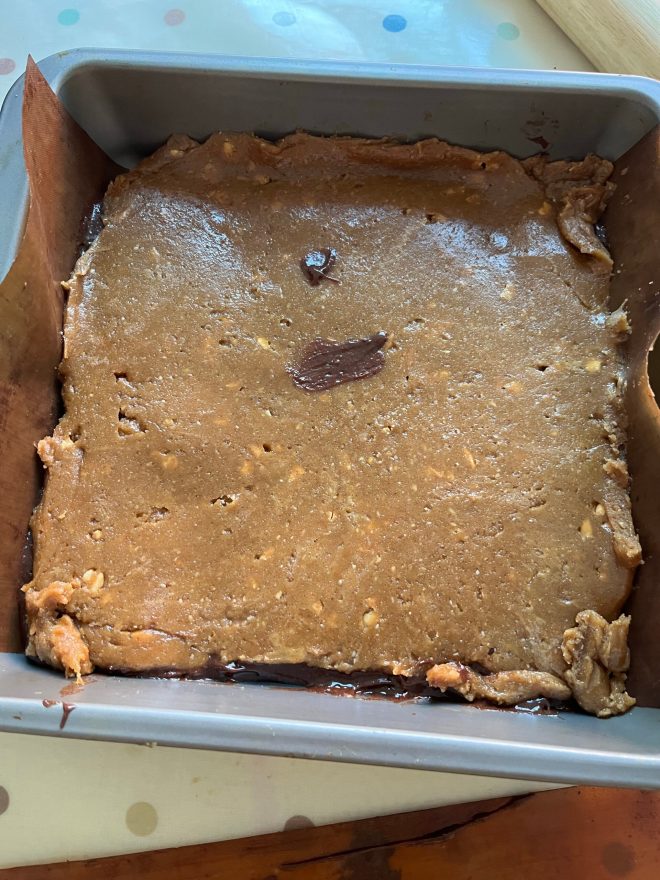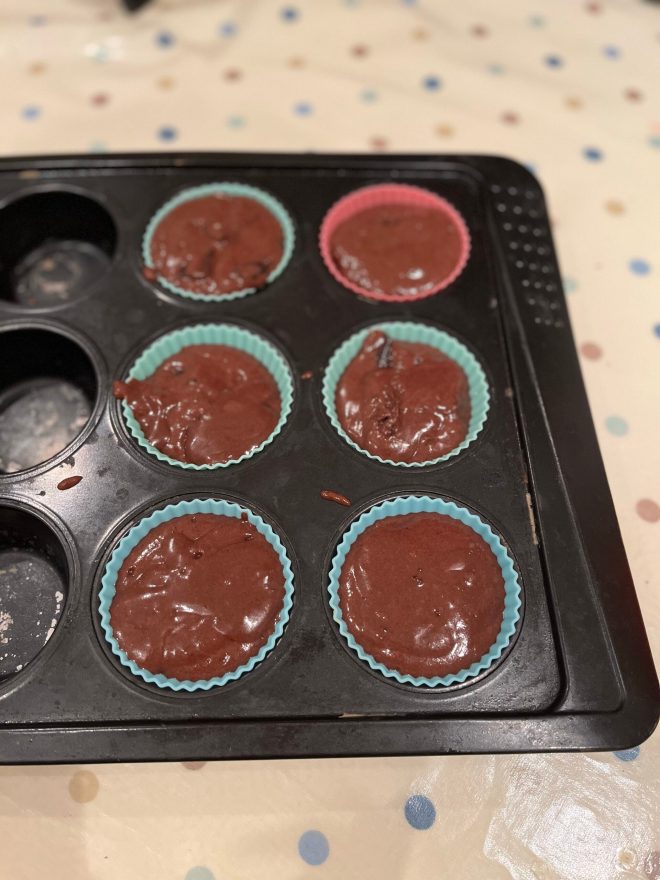
As I write this post, there is another Easter egg cookie recipe that is currently trending on the socials. The Domino’s (yup famous for their pizzas) cookie stuffed with a Creme egg. Although I normally find Creme eggs too sweet, the cookies looked like they might be fun to bake. However, before I jumped on the bandwagon, a friend, who had made them recently for her kids, reported back that they were overwhelmingly sweet. So instead, I’ve decided to make these mini egg cookies. I’ve been thinking about making them for the past three years at Easter, but was side tracked by baking hot cross buns. As a quick aside, I’ve now baked five batches this year trying to perfect Ravneet Gill’s recipe.
I wanted to make a recipe that’s simple, not overwhelmingly sweet and delicious. One that would please children and that you could make with them. Therefore I played around with my trusted cookie recipes on the blog to create this one. And as I realised how expensive a small bag of mini eggs can be, I decided this recipe had to one that could be made with one small 80-90g bag. You can, of course, use Cadbury’s mini eggs, or, like me, choose a cheaper supermarket alternative. Additionally, I wanted each of the cookies to have a whole mini egg in them. In the five times that I’ve tested this recipe, I’ve counted out between 15-17 mini eggs and set them aside, thinking that I’d get that many cookies out of the dough mixture. What a surprise then, when the medium cookie scoop kept going and presented me with more (normally 16-18)! So, what is one to do? My compromise was to leave some without, but of course you could lightly smash the eggs in half.
This is where the boob cookie nickname came in. I took them into work one day in a container which had them stacked in two columns. As I looked at them, each cookie containing one mini egg, I realised that they just looked like boobs. If ever, you’re doing some baking to raise awareness of breast cancer, then please bake these! If there are no mini eggs around, then perhaps you could substitute them with Smarties or M&M’s?

Anyway, back to creating this recipe and feel free to skip this paragraph if you don’t want to know the details. For example, in the process of making this recipe, while I was choosing between my basic chocolate cookie recipe and my brown butter one, I consulted Ravneet Gill’s The Pastry Chef. As I calculated the ratio of flour to butter, I found that the basic chocolate cookie and Ravneet Gill’s recipes have an identical flour to butter ratio of 1.78… That must be significant, right? But could someone explain to me why? So I chose to begin with the basic chocolate cookie recipe as my base. Then, as it’s been a bit cold for butter to soften in our kitchen, I decided to melt half of the butter and why not make it into brown butter while I was at it? So, of course I did because brown butter makes everything better, in my mind.

I’ve included two videos on browning butter below as I know that if this is a new thing, it can be off-putting. And I don’t want you to be put off because, remember, I set out for this recipe to be simple. I’ve always done this on a stove top, never in the microwave, so I don’t know if you can. All you are doing is evaporating the water off the butter and as the milk solids brown, it magically releases a nutty flavour. Its French name alludes to this. Beurre noisette, literally translates as hazelnut butter. You will find that I repeat a summary of this in step 1 of the method. First, you melt the butter in a saucepan on a medium heat. The butter will begin to cackle and froth as it melts (listen to Video 1). As the water continues to evaporate, it will make a gentler frothing sound (listen to Video 2). Use a spatula to stir and scrape the bottom so that it doesn’t burn. It is ready, when it is “silent as a ninja” (I quote Stella Parks) (also in Video 2). Then take it off the heat and let it cool. There are two ways really to do this. Option one is to carefully place the pan in some cold water taking care not to splash any water into the pan. This is what I do to save on washing up. Option two is the more orthodox method of pouring the butter into a heat proof bowl, taking care to scrape all the brown bits into the bowl and letting it cool.
A quick word on equipment. My happy discovery whilst making this recipe is that I can use a pestle and mortar to smash the chocolate and mini eggs. It’s much easier and less messy. The mini eggs don’t roll away as you’re trying to cut them. If you don’t have a pestle and mortar, you could place them in a bowl (that won’t break) and smash them gently with the end of a wooden rolling pin. I’m going to keep on using this. I’m also using my latest kitchen equipment purchase – Vollrath’s #30 cookie scoop, as I’ve chosen to make them medium sized. Each one weighs between 40g-43g. I share this with you because I searched the internet to find something good to replace my previous OXO #40 cookie scoop after it died. It appears that OXO UK don’t offer the #40 cookie scoop anymore, but the larger one instead. Finally, I’ve made them in a stand mixer but you could easily make them using a hand mixer or by beating the mixture by hand.


Recipe for Smashing mini egg cookies with brown butter
- 140g butter, 70g cubed and 70g to melt into brown butter
- 110g white sugar – granulated or caster
- 120g soft dark brown sugar
- 1/4 tsp bicarbonate of soda
- 1 egg
- 1/2 tsp vanilla extract
- 230g plain flour
- 1/4 tsp salt
- 160g total of chocolate
- I used a 80g bag of mini eggs – pick out 15-17 whole and lightly crush the rest – and 80g of 70% dark chocolate roughly chopped. Alternatively, you could use 80g of dark chocolate chips.
Method
- First make the brown butter. Melt 70g butter in a small saucepan on a medium heat. It will froth and cackle as the water evaporates. This is normal. Scrape round the sides and the bottom of the pan so that it doesn’t burn. When it is silent, then it is ready. Take the saucepan off the heat and leave to cool slightly.
- Meanwhile in a medium sized bowl, measure out both the sugars, the remainder of the butter and bicarbonate of soda and then pour in the brown butter. Remember to scrape all the brown bits into it too. Then mix it together until they’ve all combined.
- Next, add the egg and vanilla extract and mix to combine.
- In a small bowl, combine the flour, salt, crushed mini egg bits and the dark chocolate chunks. Add this to the butter/sugar/egg mixture and mix on slow so that the flour doesn’t all fly up.
- Next the cookie dough needs a rest for at least 12 hours in the fridge/freezer. Get a medium sized baking tray and line it with baking paper/silicone baking mat. I like to use a medium sized cookie/ice cream scoop for this next bit to measure out and shape the cookies. If you don’t have a cookie scoop then measure out a golf ball sized ball of cookie dough and roll it into a ball. Place the balls side by side on the baking tray. Once you’ve done that, take the whole mini eggs that you’d reserved and firmly push one into each ball.
- I like to cover them with an empty, used cereal packet that is large enough for the baking tray to go into, and then carefully place the tray in the fridge or freezer so that the cookie dough balls rest overnight. This is important for creating chewy cookies so don’t hurry this step! The magic happens here the sugar in the dough hydrates and allows it to caramelise when baked. If I freeze them, the next day I empty the frozen balls into the cereal packet to store.
- When you come to bake them, preheat the oven to 160°C/320°F/Gas mark 3. Line a baking tray with baking paper and place the cookie balls on the tray, spacing them out by 2-3 cm as the cookie will spread out. Sprinkle the balls lightly with salt and then bake in the middle of the oven for 14 minutes if they’ve been in the fridge, 16 minutes if they’ve been in the freezer until they are puffed up and golden. I turn the baking tray round halfway because of hot spots in my oven. Allow them to cool for 5-10 minutes, in which time they will deflate and be crispy on the outside and still gooey inside. The 5-10 minutes cooling wait time before eating is also so that you don’t burn the roof of your mouth. I speak from experience. Enjoy.
The verdict? They are smashing! The sprinkling of salt and addition of dark rather than milk chocolate keeps them from being overly sweet. I have tested and tweaked this recipe 5 times before I hit publish. I’ve given them away at work, aerial, and to whoever walks in the door, young and old. The general consensus is that they are delicious, which is good as I’ve still got a stash in the freezer.








































































